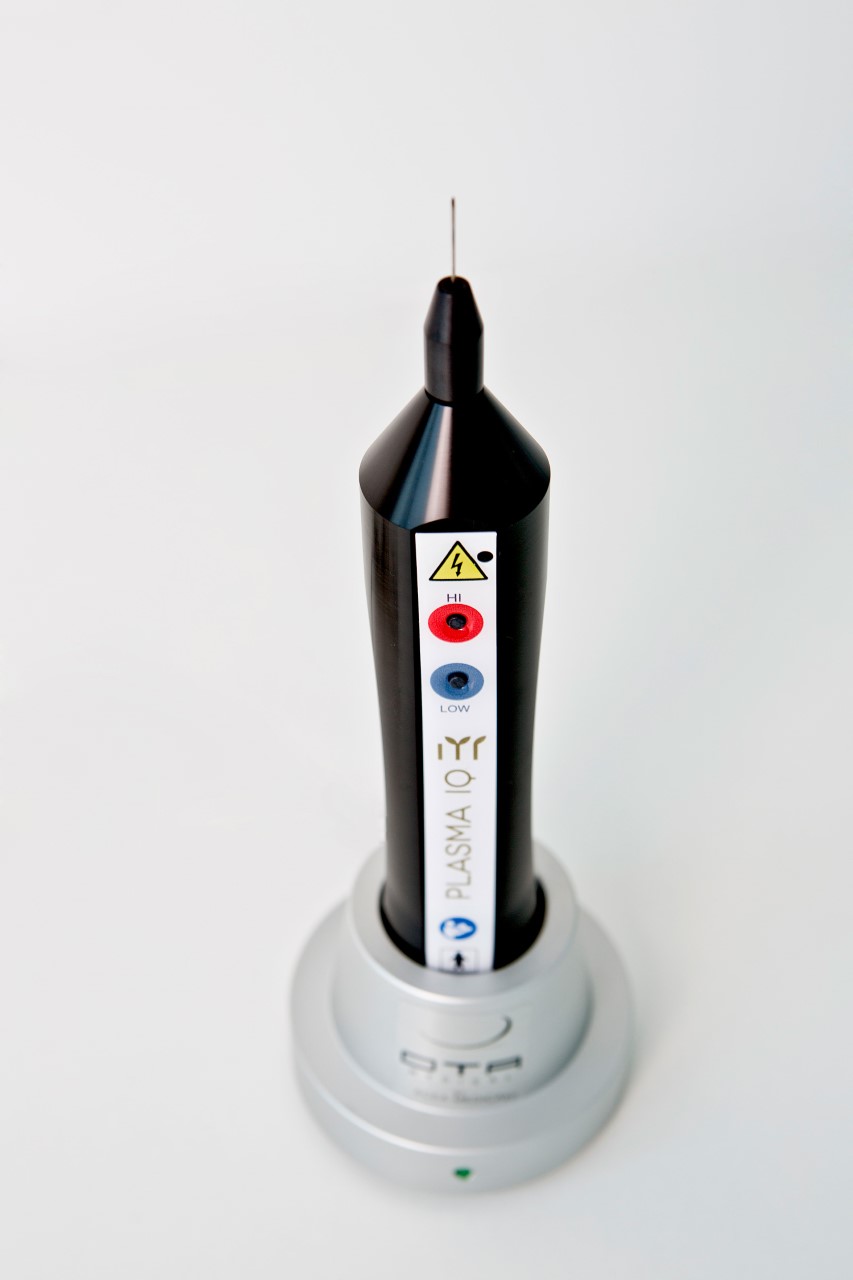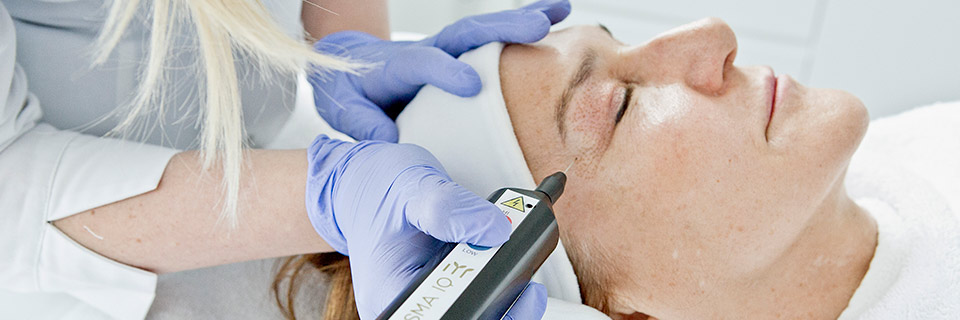 Product Summary
Product SummaryThe Plasma IQ was launched into the UK cosmetic marketplace in 2016. It is manufactured in Italy by DTA Medical, and distributed in the UK by Schuco. It is an innovative, rejuvenating treatment method that utilises the fourth state of matter: Plasma.
Plasma is used for a treatment method called plasma sublimation, which causes controlled skin damage and creates tightening and retraction of the skin tissues. A healing response is triggered which then causes new collagen formation in the area being treated. This is used to improve lines and wrinkles, scars and stretch marks, as well as offering solutions such as non-surgical treatment of the eye lid area; a non-surgical blepharoplasty.
It offers a low risk procedure, with minimal side effects, and none of the complications associated with surgical interventions. Therefore, it is an ideal solution for those who prefer the non-surgical route for skin rejuvenation treatments.
The hand-held, rechargeable device comes with four power setting options so the practitioner can choose the most appropriate setting for your treatment. It uses disposable, per patient needles to deliver the plasma energy.
The device works through the generation of a targeted micro beam of plasma energy, which causes epidermal sublimation, without affecting the surrounding tissue. The use of plasma is becoming an increasingly common, minimally ablative treatment method, which is much quicker than surgical solutions, and offers less down time.
Plasma is a recent innovation in the world of aesthetic medicine. The Plasma IQ works by creating an arc between the device tip and the skin, by ionising the gas particles in the air in the space. The resultant production of plasma causes sublimation of the epidermis of the skin; turning a solid straight into gas. This causes skin retraction and tightening in the target area, as well as helping to stimulate the production of collagen from the healing response.
This method of plasma sublimation utilised by Plasma IQ is so precise that no heat is transferred to the surrounding area. It creates 1mm2 treatment spots. This means that it can be used to treat more sensitive areas, such as the eyelids, which are not always suitable for other non-invasive methods, like lasers or radio frequency.
Plasma IQ is manufactured in Italy and is CE mark certified in Europe as a Class IIb medical device, (CE 0068). The efficacy and safety has been tested and confirmed in clinical studies.
Treatment with the Plasma IQ device should only be by fully trained medical professionals such as doctors, nurses and dentists, who can provide any necessary certifications upon request. The company who distribute the device in the UK do not train aestheticians or beauty therapists in its use.
Use your consultation as an opportunity to learn more about your practitioner and their experience with the procedure. Ask any questions you need to, so you feel comfortable proceeding with treatment.

Following a full treatment regime, the effect should last for as long as a comparable surgical treatment. However, the effects cannot be regarded as permanent, as it does not halt, nor prevent the ageing process.
You can expect the positive results to last several years if you avoid lifestyle factors that contribute to skin ageing and damage. You should avoid smoking, excess alcohol consumption and prolonged sun exposure to get the full benefit from your Plasma IQ treatment.
Treatment with Plasma IQ is considered a low risk procedure in the right hands; however, there may be some minor side effects and risks.
Treatment is said to be relatively uncomfortable, depending on your tolerance to pain. The delivery of the plasma produces a stinging feeling. A topical anaesthetic cream is usually applied to numb the area before treatment starts, to reduce such sensations. Your practitioner may also offer other solutions, such as cold air coolers if you are particularly sensitive to pain.
Immediately after treatment, the affected area may feel tender, with slight burning and tingling sensations, but this should only last for a few hours. Later you should expect continued tenderness, redness, swelling and mild discomfort in the treated area, for several days, to a week. Swelling is more common in the area around the eyes.
The points of sublimation are about 1mm in diameter, showing as tiny brown carbon crusts or scabs. These will remain for at least a week before dropping off. It is very important that the crusts are left to heal without any interference, to prevent scarring, infection or pigmentation abnormalities
You must not scratch or pick the area during healing. The area should be kept dry and clean, and protected with a UVA/UVB sunscreen, until fully healed, to prevent infection. If, at any time, the treatment area becomes bright red, hot and tender, contact your practitioner as soon as possible.
One of the more common risks is a change in the pigmentation of the skin in the treated area, either becoming lighter (hypo-pigmented) or darker (hyper-pigmented). To prevent this, your practitioner will advise you with a bespoke aftercare routine.
Furthermore, hair follicles may be damaged during treatment, resulting in hair loss within the treated area.
As with any cosmetic procedure, it should not be used on those who are pregnant or breastfeeding.
Although it is a suitable treatment for most skin types, it is not advised for those with very dark skin, because of the risk of hypopigmentation that can occur after treatment; a risk that is increased if the carbon crust scabs are disturbed.
Due to the stinging sensation that can be felt during treatment, those with a low threshold to pain, may want to discuss if they will be able to tolerate the procedure, or if there are other pain relief options available to them.
Plasma IQ should also not be used on skin conditions such as scleroderma, facial shingles or severe recurrent cold sores (herpes simplex virus). It also should be avoided by those on steroid medications.
Furthermore, this treatment is not suitable for large eye bags, where excess fat is the main problem; this requires a surgical intervention.
Before treatment begins, a local anaesthetic cream is applied to the target area for approximately 40 minutes, to ensure sufficient numbness. The treatment commences with multiple shots of the Plasma IQ tip, spaced very close together. There will be a sensation of heat in the treatment area, which may become uncomfortable and painful, but the procedure should only last between 10-40 minutes; on average 20 minutes.
Typically, more than one treatment session is recommended for optimum results, depending on the area and indication being treated. If more than one session is required there should be 6 weekly intervals between each one. Often up to three treatment sessions are needed to replicate the effect of a surgical intervention.
There will be visible results following just one treatment with Plasma IQ. Your practitioner will be able to give you an idea of how many treatments you will need at your consultation. Results will vary from person to person.
The cost of Plasma IQ treatment will vary between different clinics and practitioners. You can expect to pay approximately:
Upper Eye Area - £300
Full Eye Area - £500
Full Treatment of Both Eyes - £800
Smokers Lines - £400
Skin Imperfections – Prices starting at £100 depending on the extent of treatment needed.